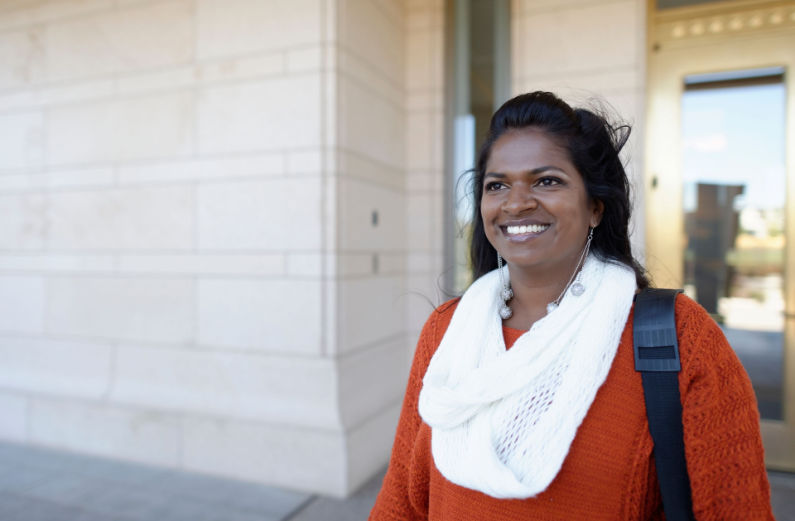In recent years, I have learned more about women’s issues and paid closer attention to both the inequalities between women and men in our society, as well as spaces that have actively elevated women. I am so proud to be a Latter-day Saint woman, especially now. In recent years, the Church has updated policy and practice that invite women to be greater contributors, especially in more visible and equal roles.
These updates have strengthened my testimony of our Heavenly Parents’ love, and of modern-day prophets. I think each of us has a gospel- or Church-related question that we figuratively “put back on the shelf.” We have done all the study, pondering, and praying we can and still have not gotten a full answer or understanding. One of mine is why women seem to have a primarily “support the man” role in society, including Church culture and in some scriptures. For about the last five years, I have prayed about and studied women in the kingdom, and I have been comforted and led to many resources that have helped answer my question.
The recent changes and clarifications regarding women in the Church have confirmed to me what the Spirit has whispered to me the last five years: Heavenly Father loves His daughters and sons equally, and the Church is not immune from the cultural traditions of humanity. In time, things will feel more equal.
If your question on the shelf is bothering you, I implore you to please hold on! If things don’t seem fair, equal, respectful, or make sense now, just hang on — culture and incorrect tradition will be corrected and changed.
Women Participating More Visibly
 President Nelson’s time as prophet will definitely be remembered for the many changes he authorized. It seems he (and those he counseled with) have examined traditions and culture and sifted out those which are outdated, exclusive, and whose purposes have faded with time.
President Nelson’s time as prophet will definitely be remembered for the many changes he authorized. It seems he (and those he counseled with) have examined traditions and culture and sifted out those which are outdated, exclusive, and whose purposes have faded with time.
Many of these changes better emphasized the equality of women in the kingdom by lifting their voices and giving them more visible opportunities to serve and become involved. A few notable changes include:
- Women and girls can serve as witnesses for live and proxy baptisms and sealings.
- Temple ceremony wording and presentation changed to eliminate references to a subservient role for women.
- The Young Women theme is new and starts with “I am a beloved daughter of Heavenly Parents,” which reminds young women of their Heavenly Mother.
These changes meant a lot to me because they plainly showed that women were excluded in ordinances and in the temple based on culture, not doctrine. It shows that women and girls are valued in the work of salvation. I also love the inclusion of Heavenly Mother in the Young Women’s theme because teaching more openly about Heavenly Mother shows girls their true divine nature and destiny.
In 2015, before President Nelson became the prophet, the Relief Society General President began serving on the Priesthood and Family Executive Council, the Young Women General President began serving on the Missionary Executive Council, and the Primary General President began serving on the Temple and Family History Executive Council. This is significant because all these Presidents are women, and their input and knowledge is being considered on these councils which make Church policy.
President Bonnie L. Oscarson, the Young Women General President at the time, posted on Facebook about her new assignment:
“What a great time to be a woman in the Church where our voices are needed and valued more than ever. I am grateful for the opportunity to add my perspective and experiences to this council as we work together to spread the message of the restored Gospel.”
I am grateful women are being invited to participate more fully and more visibly in the Church than ever before. I’m grateful for Church councils I have participated in. I learned that even though it seems like the bishop makes key decisions, it really is a counseled effort most times. One of my bishops used many of my ideas for Sacrament meeting speakers and topics. As a missionary, I was a Sister Training Leader which allowed me to serve the sisters better and voice their concerns at Mission Leadership Councils and to my mission president and his wife (who was also very involved in her missionaries’ well-being). I have great hope for our times and the future generations.
Doctrine, Principles, Application, and Culture
 For the first two years of our marriage, my husband and I taught the teenagers’ Sunday School class in our congregation. We enjoyed discussing the gospel with these teens. One Sunday, we based our lesson off of Elder Bednar’s teachings about the difference between doctrine, culture, application, and culture. (We added culture.) My husband and I made categories on the chalkboard and listed things for our class to categorize.
For the first two years of our marriage, my husband and I taught the teenagers’ Sunday School class in our congregation. We enjoyed discussing the gospel with these teens. One Sunday, we based our lesson off of Elder Bednar’s teachings about the difference between doctrine, culture, application, and culture. (We added culture.) My husband and I made categories on the chalkboard and listed things for our class to categorize.
Elder David A. Bednar teaches in his book Increase in Learning that doctrine is “a truth of salvation revealed by a loving Heavenly Father,” and that “they are relatively few in number.” Doctrine answers the question why? Examples of doctrine include the nature of the Godhead, the plan of happiness, and Jesus Christ’s Atonement.
A principle is “a doctrinally based guideline for the righteous exercise of moral agency.” Principles provide direction and answer what? Examples include love, unity, and prayer as principles to the doctrine that God is our loving Heavenly Father.
Applications are the “actual behaviors, action steps, practices or procedures by which gospel doctrines and principles are enacted in our lives,” (156). Applications answer how? Studying the scriptures and attending church are applications to the principle of faith in Jesus Christ, which we do because of the doctrine that we are saved through Jesus Christ.
Our teenage class categorized things pretty well. However, the “culture” category stumped our class a few times. For example, they categorized “having lots of kids” as a principle.
This activity with our teenagers reminded me how important it is to understand the difference between doctrine, principles, applications, and even culture. My own personal faith struggles aren’t because of doctrine, but because of culture. I would also venture to say that much of the Church’s critics take issue with things categorized as application or culture, but rarely doctrine.
Culture, or “the incorrect traditions of our fathers” as the Book of Mormon puts it, is not unique to Latter-day Saints. Critics of the Church have long pointed out the backseat that women seem to take. However, that is evidenced in society, not just the Church. The culture of society is embedded deep within each of us, and it can be hard and uncomfortable to change.
In her book The Priesthood Power of Women, Barbara Morgan Gardner said she was told she could not serve in certain Church capacities because she is a woman. She was told she could not become a full-time seminary teacher or institute coordinator because “they don’t hire women” and “you need the priesthood to be a coordinator, especially in the East.” Sister Gardner became both a full-time seminary teacher and the institute director and seminary coordinator in the Boston, Massachusetts area. She also served as the Latter-day Saint chaplain at Harvard and MIT. She says of that appointment:
“I was not shocked that both Church members and those not of our faith tradition were surprised to have a woman serving as a chaplain. Frankly, I was too! There was no change in policy; it just simply hadn’t ever happened before” (134).
Sister Gardner’s last line is cause for reflection — what else do we do just because it has always been done that way? President Nelson and other Church leaders seem to have been asking that question a lot in recent years. I am grateful they have.
Doctrine Will Overcome Incorrect Cultural Practices
 If you feel marginalized, ask yourself “is this just culture, or is it doctrine?” My guess is it will likely be culture.
If you feel marginalized, ask yourself “is this just culture, or is it doctrine?” My guess is it will likely be culture.
In the Book of Mormon, the prophet Nephi teaches God loves all His children equally:
“He inviteth them all to come unto him and partake of his goodness; and he denieth none that come unto him, black and white, bond and free, male and female; and he remembereth the heathen; and all are alike unto God, both Jew and Gentile.”
Our Savior Jesus Christ suffered for each one of us. Not just men, not perfect members, not just the person who looks like they have it all together — everyone! Each person is dear to our Savior, and He shed drops of blood for each of us. Jesus Christ’s infinite and eternally-inclusive atoning sacrifice shows how much He and our Heavenly Parents care about all of Their children.
The blessings promised to covenant-keeping Saints are so good and so real. Please hold on to your faith and your covenants. You know that God loves you and all His children equally. God will not let you down.
“Except in the case of His only perfect Begotten Son, imperfect people are all God has ever had to work with,” Elder Holland said in general conference. “That must be terribly frustrating to Him, but He deals with it. So should we. And when you see imperfection, remember that the limitation is not in the divinity of the work.”
It is an exciting time to be a woman in Christ’s Church. We are all needed in God’s kingdom as we are. Our unique experiences, perspectives, backgrounds, voices, and ideas are vital to helping our sisters and brothers receive all the blessings God has for us.
About Kristine Hoyt
Twitter •







Great thoughts! Women’s perspective and minds are often so different from men’s and that is so important and helpful- whether in the church or in families. God made male and female to compliment each other (help meet means equal). We are always better off giving women a voice.